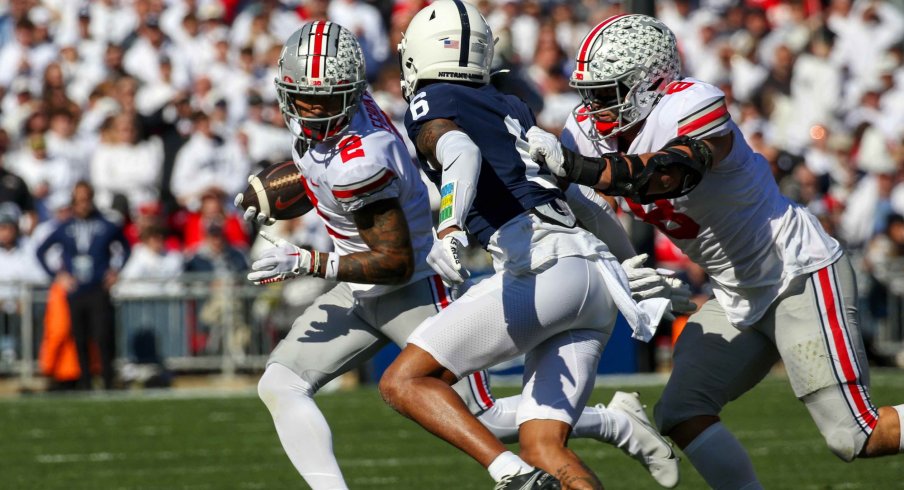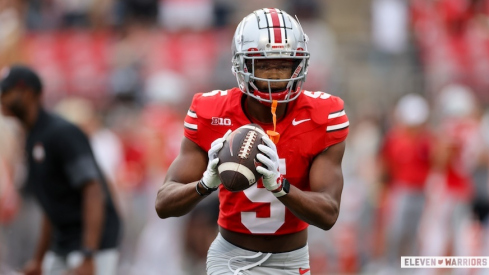"It's always a great play if it works. If it doesn't work, it's just an awful play call. I've learned that over the years." - Ryan Day
Throughout last Ohio State's most recent trip to Beaver Stadium, it's very likely that you, a reader of Eleven Warriors Dot Com, said 'why do they keep trying to throw bubble screens?' with varying levels of bewilderment and frustration.
For although the Buckeyes ultimately left Happy Valley with a double-digit victory and a still-unblemished record, the vaunted offense led by a Heisman contender at quarterback looked downright ordinary at times. Time after time, it seemed as though Stroud's passes went sideways with a Penn State defender making a tackle for no gain.
The consistent narrative about last Saturday's contest is one of superstar talent stepping up when OSU needed it most. Marvin Harrison Jr. cemented his place as the nation's best receiver while J.T. Tuimoloau played the best game anyone has possibly ever seen from a Buckeye defensive end.
But to assume that those superhuman efforts saved the Buckeyes from terrible play-calling would be a mistake. The consistent diet of wide receiver screens was the correct remedy for what Manny Diaz's defense brought to the table, often pressing bodies near the line of scrimmage to sell out against the run or pressure Stroud into a bad throw, leaving large swaths of open space on the edges.
Indeed, the Buckeyes found themselves trailing in the fourth quarter due not to scheme, but to their offensive execution up to that point. Just as the wide receiver corps failed to engage their blocks on the edges, the big men up front were consistently driven off the ball and into the lap of TreVeyon Henderson before he ever had a chance to make a play.
While crowd noise and a rarely-used silent count can help explain why OSU offensive linemen often looked slow to get out of their stances. credit must also be given to their opponents. Diaz did an excellent job of preparing the Nittany Lions to execute his plan, familiarizing them with the Buckeyes' tendencies while getting them to play with maximum effort.
Much as we've seen from Jim Knowles since his arrival in Columbus, Diaz's approach to facing the visitors from Columbus largely threw caution to the wind, looking to dictate the action on his terms.
Knowing Ohio State would largely rely on zone runs, the former head coach of the Miami Hurricanes consistently blitzed on early downs and slanted his linemen to blow up the blocking scheme.
“Can we clean things up? Yeah, but that's football and you see it every single week, you see games go back and forth," Day said after the game, complimenting his opponent. "And again, a lot of respect for Penn State. This environment is a hard place to play, and it always is.”
As the game wore on, however, Diaz's plan became more predictable and Day adjusted in kind. With the Nittany Lions sending run blitzes on first down, the Buckeyes began lining up in 5-wide formations, getting the ball out into empty space before the pressure could arrive.
Knowing how explosive the Buckeyes are at wide receiver, Diaz elected to hedge his aggressiveness by keeping his safeties deep while asking linebackers to sell out against the run. This left the intermediate areas wide open, especially when OSU played with two tight ends, their preferred personnel group in run situations.
Despite its early struggles in the run game, the Buckeye offensive line did a good job of identifying pressure as the game wore on. While Penn State blitzed on 23% of his dropbacks, Stroud was only pressured on 8% of them, allowing him to identify holes in coverage and deliver accurate passes.
But the Buckeyes also learned from their early mistakes and began to look to Harrison more and more as the game went on. Facing the same look from Penn State that had led to a number of blown-up bubble screens earlier in the game, Stroud elected to look the opposite way and trust his all-world wideout to beat his man on a critical fourth down.
“Obviously, they’re a very talented secondary, probably the best we’ll see all year," Stroud said after the game. "We just had to be prepared, had to bring our A-game for it, for sure.”
But the OSU ground game also kicked into high gear as the game wore on. While Penn State seemed prepared to stop zone runs outside the tackles, the inside zone runs proved largely successful all afternoon, regardless of whether they were executed from the shotgun, pistol, or under center.
On the go-ahead drive midway through the fourth quarter, the Buckeyes called for an inside zone run with the added element of an uptempo cadence, snapping the ball before the defense was set and getting the kind of push that had been absent in the first half.
With the run game finally engaged and a lead in hand, Day had finally forced Diaz to abandon his game plan and begin packing the box to stop it. But once again, the Buckeyes were a step ahead, throwing downfield and attacking man coverage.
Though the process may have been more tedious than many within the OSU fanbase would have liked, it's important to recognize the team's performance within the right context. The Penn State defense features two of the best defensive backs in the conference (including perhaps the nation's best cornerback), is led by an experienced coordinator who has a history of knocking off higher-ranked opponents, and had the support of one of the loudest crowds in any sport.
Yet at the end of the day, Ohio State still managed to average a gain of 7.53 yards every time they snapped the ball in State College. The Buckeyes' performance may not have been perfect (especially when blocking those bubble screens), but it was more than enough to pass the toughest test of the season thus far.
“Some things certainly we want better, but at the end of the day, great to get a win. When we go into these games, the expectation is to win,” Day said. “I know that's not everybody's expectation. That's alright. Do we want to play perfect? Yeah. Do we want to win by four touchdowns? Yeah. But the expectation coming in here has to be to win, and that's what we did.”



